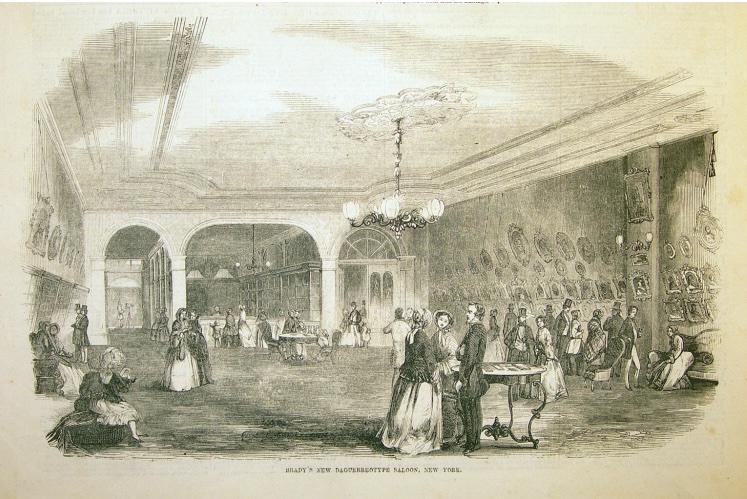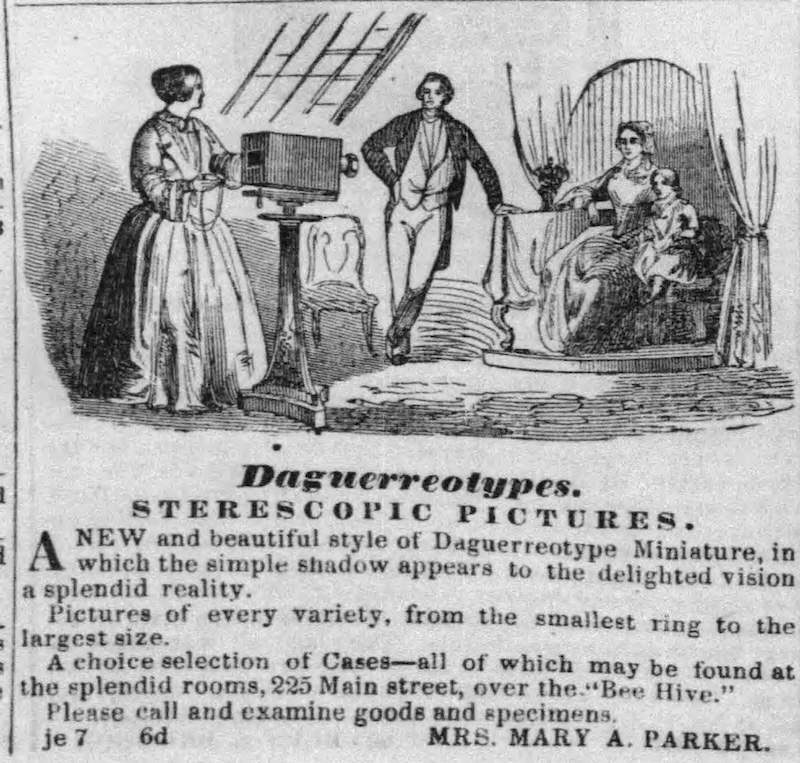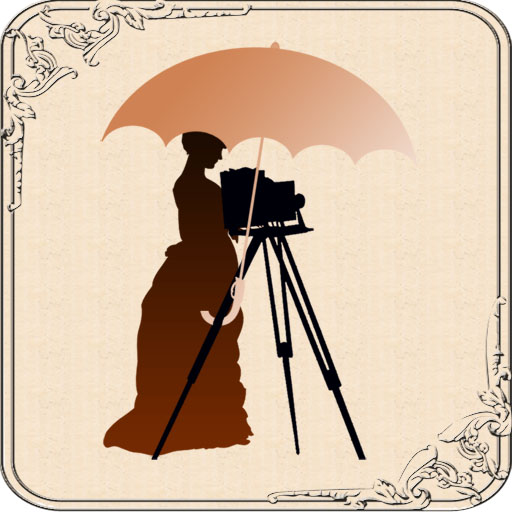Today is the start of a new series on the blog that I’m calling “Early PICT.” PICT stands for “Photographer in Connecticut”; although “women” is not in the name itself, the series will of course focus on early women photographers in Connecticut. This series will appear on the blog from time to time throughout all of 2025.
In this, the inaugural “Early PICTs” post, we meet two very early women photographers from Connecticut: Miss Ethel P. Kinne of Norwich and Mrs Mary A. Parker of Hartford. Miss Kinne and Mrs Parker were both daguerreian artists (aka “daguerreotypists”) in the 1850s. In other words, they earned a living by making daguerreotypes, the earliest commercially available type of photographic image.
The title of this post comes from a notice for Mrs. Parker’s new Hartford establishment in May 1853:

Note that “saloon” here is used in the sense of “a stylish business establishment or shop”, which is a definition of the word “saloon” according to the Meridian Webster dictionary. Of course, this meaning of the word “saloon” is not commonly used in the 21st century.
But in 1853 it was apparently used regularly to refer to a daguerreotype establishment. For example, here’s an ad for “Brady’s New Daguerreotype Saloon” from 1853:

(BTW, “Brady” here is the photographer Mathew Brady. Yes, that is the same Mathew Brady who will later become famous for photos made in the 1860s during the American Civil War. That fact is neither here nor there, nor is it related to this post. I bring up Brady’s ad only to show how the usage of “saloon” for a Daguerreian artist’s establishment was commonplace in 1853.)
I didn’t find any ads for Miss Kinne in the newspaper, so I don’t know if she had any place she called a “Daguerreian Saloon”. [I should note that Miss Kinne is listed as a daguerreian in the Norwich city directories from 1853-1858 acording to this site; I haven’t been able to independently verify this fact since Norwich city directories before 1859 are not available online. ]
Miss Kinne’s story ends quite suddenly, as she dies in 1859 at the age of only 29. One of the few online records for Ethel P. Kinne that I do have access to is a property inventory done for the probate of her estate after her death. The inventory lists an interesting mix of personal items (e.g. 2 vests, 1 pair linen pants, 1 silk handkerchief, etc.) as well as presumed professional equipment (e.g. a variety chemicals, mercury baths, 2 plate cameras, plate holders, and cases of different sizes and materials that could have been for the final daguerreotypes. Items also on the list such as “1 clock, 4 Headrests, 3 looking glasses, etc.” could have been from her “saloon” or could have been for her personal use – it’s hard to say for sure. I mean, the “headrests” here might refer to the devices that were to keep a sitter’s head immobile during the long exposure time required for a daguerreotype – often these devices were called “posing headrests”, I think.
[If you’re curious, you can see the whole set of probate papers for Ethel Kinne here, but you will need to have an Ancestry.com account (or sign up for a free trial account).]
While Miss Kinne’s career was cut short by her death, she was at least in business for five or six years according to the Norwich city directories. Mrs Parker, by contrast, was seemingly only running her “saloon” for 2 years, according to the Hartford city directories. But Mrs. Parker was very prolific during that time: by the end of 1853 alone, her work was winning awards and being mentioned in positive write-ups in the press. For example, there’s a long article in the newspaper in December 1853 with a year-end report from the Hartford County Agricultural Society. Included in that report is the following mention of Mrs. Parker’s work:

the Hartford County Agricultural Society
Hartford Courant, December 26, 1853
But as I mentioned, Mrs. Parker is listed as a daguerreian artist in the Hartford city directory only from 1853-1854. Chris and I have been unable to determine anything more about Mrs. Mary A. Parker, so there are many things remain a mystery about her, e.g. when she was born, when she died, what her maiden name was, when she got married, and/or if she continued to do photography after 1854.
Now, daguerreotypes are rarely signed by the artist, so finding any examples of works by Mis Kinne and Mrs Parker is difficult, if not impossible. But I do at least have one final trace of Mrs. Parker to share. While I’m not sure when people in general stopped using “saloon” to refer daguerreotype establishments, Mrs. Parker stopped using the term almost immediately. Just one month after that first notice in May 1853, Mrs. Parker takes out fhe following ad for her business that no longer uses the term “saloon”:

What a nice ad, eh?
Anyway, finding two early women photographers who were doing daguerreotypes was a fun way to kick off the new “Early PICTs” series here on Photographs, Pistols & Parasols.
P.S. Click here to visit a website with a really nice description of what it is like to experience the “magic of daguerreotypes.”

4 thoughts on “Early PICTs: Two Daguerreian “Saloons””
Comments are closed.